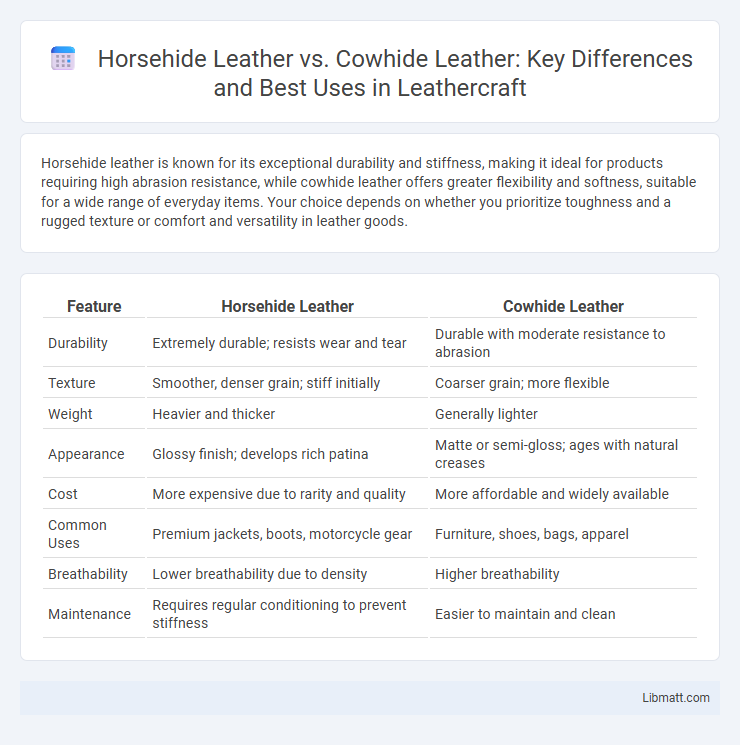Horsehide leather is known for its exceptional durability and stiffness, making it ideal for products requiring high abrasion resistance, while cowhide leather offers greater flexibility and softness, suitable for a wide range of everyday items. Your choice depends on whether you prioritize toughness and a rugged texture or comfort and versatility in leather goods.
Table of Comparison
| Feature | Horsehide Leather | Cowhide Leather |
|---|---|---|
| Durability | Extremely durable; resists wear and tear | Durable with moderate resistance to abrasion |
| Texture | Smoother, denser grain; stiff initially | Coarser grain; more flexible |
| Weight | Heavier and thicker | Generally lighter |
| Appearance | Glossy finish; develops rich patina | Matte or semi-gloss; ages with natural creases |
| Cost | More expensive due to rarity and quality | More affordable and widely available |
| Common Uses | Premium jackets, boots, motorcycle gear | Furniture, shoes, bags, apparel |
| Breathability | Lower breathability due to density | Higher breathability |
| Maintenance | Requires regular conditioning to prevent stiffness | Easier to maintain and clean |
Introduction to Horsehide and Cowhide Leather
Horsehide leather, known for its exceptional durability and smooth texture, is derived from the hide of horses, offering a denser fiber structure compared to cowhide. Cowhide leather is more widely available, prized for its versatility, toughness, and ability to develop a rich patina over time. Your choice between horsehide and cowhide depends on the intended use, with horsehide being preferred for garments requiring sturdiness and cowhide often favored for general-purpose leather goods.
Historical Uses of Horsehide vs Cowhide
Horsehide leather has historically been prized for its exceptional durability and water resistance, often used in military gear, flight jackets, and heavy-duty work gloves since the early 20th century. Cowhide leather, more abundant and versatile, has been widely utilized for a broad range of products, including saddles, footwear, upholstery, and fashion accessories, dating back centuries across various cultures. Understanding these traditional uses can help you choose the right leather based on longevity and specific functional qualities.
Key Characteristics of Horsehide Leather
Horsehide leather is known for its exceptional durability, dense fiber structure, and smooth, glossy finish that improves with age. It offers superior abrasion resistance and a unique stiffness compared to the more flexible and softer cowhide leather. Your choice of horsehide leather ensures a long-lasting product with a distinctive, rugged aesthetic ideal for jackets and boots.
Key Characteristics of Cowhide Leather
Cowhide leather is renowned for its durability, thickness, and resistance to wear, making it ideal for heavy-duty applications such as furniture and footwear. It features a coarse grain structure with natural imperfections that enhance its rugged appearance and strength. Cowhide also ages well, developing a rich patina over time which increases its aesthetic and functional value.
Durability Comparison: Horsehide vs Cowhide
Horsehide leather is known for its exceptional durability and toughness, often exceeding cowhide in resistance to abrasion and stretching due to its denser fiber structure. Cowhide leather, while durable, tends to be more flexible and less stiff, making it more prone to wear over time compared to the rigid nature of horsehide. The increased density and tight grain of horsehide provide superior longevity, especially in heavy-use applications like motorcycle jackets and boots.
Texture and Appearance Differences
Horsehide leather features a tighter, denser grain with a slightly stiffer texture, offering a smooth, glossy finish that develops a rich patina over time. Cowhide leather presents a softer, more pliable texture with a looser grain, often displaying natural imperfections and a matte to semi-gloss finish. These distinct textural and visual characteristics make horsehide more durable and polished, while cowhide provides greater flexibility and a varied appearance.
Weight and Thickness Analysis
Horsehide leather is generally denser and thicker than cowhide leather, offering superior durability and resistance to wear. Cowhide leather tends to be lighter and more flexible, making it suitable for garments requiring ease of movement. Your choice depends on whether you prioritize robust thickness and weight or a lighter, more pliable leather for comfort.
Water Resistance and Breathability
Horsehide leather offers superior water resistance compared to cowhide leather due to its denser fiber structure, making it ideal for wet conditions. Cowhide leather provides better breathability, which enhances comfort by allowing moisture to escape and preventing overheating. Your choice depends on whether you prioritize moisture protection or ventilation in leather goods.
Common Applications in Fashion and Industry
Horsehide leather is prized in fashion for its stiffness, durability, and unique grain pattern, making it ideal for high-end jackets, boots, and accessories that require long-lasting wear and a distinctive look. Cowhide leather, known for its versatility, softness, and ease of processing, dominates both fashion and industrial applications, including upholstery, belts, wallets, and protective gear, supporting a wide range of durability and aesthetic needs. Your choice between horsehide and cowhide should consider the specific demands of the product, balancing texture and strength to meet functional and stylistic preferences.
Choosing the Best Leather: Horsehide or Cowhide
Horsehide leather offers superior durability and a unique grain pattern that develops a rich patina with age, making it ideal for heavy-use items like jackets and boots. Cowhide leather is more widely available, generally softer, and provides greater versatility for products ranging from upholstery to accessories. Selecting between horsehide and cowhide depends on the desired balance of toughness, appearance, and flexibility for the intended application.
Horsehide leather vs cowhide leather Infographic

 libmatt.com
libmatt.com